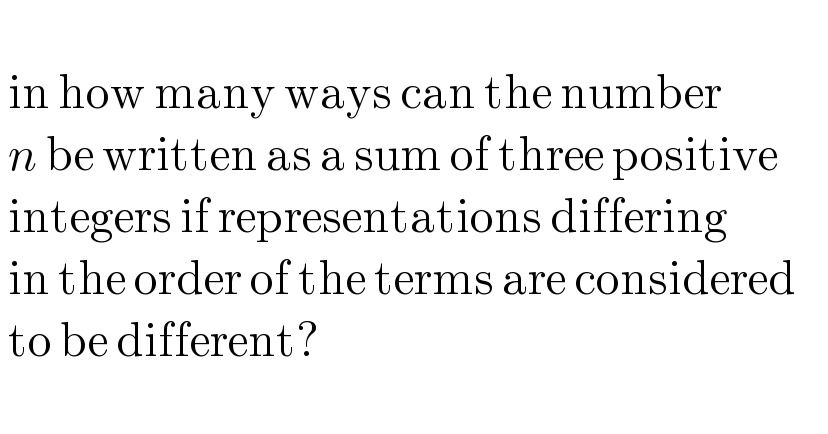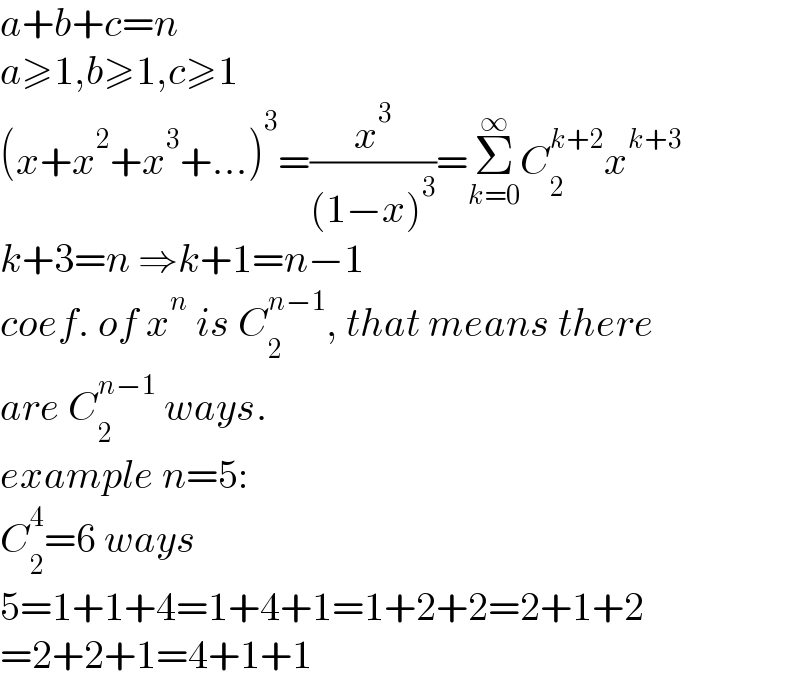
Previous in Permutation and Combination Next in Permutation and Combination
Question Number 153220 by talminator2856791 last updated on 05/Sep/21

$$\: \\ $$$$\:\mathrm{in}\:\mathrm{how}\:\mathrm{many}\:\mathrm{ways}\:\mathrm{can}\:\mathrm{the}\:\mathrm{number}\:\: \\ $$$$\:{n}\:\mathrm{be}\:\mathrm{written}\:\mathrm{as}\:\mathrm{a}\:\mathrm{sum}\:\mathrm{of}\:\mathrm{three}\:\mathrm{positive}\:\: \\ $$$$\:\mathrm{integers}\:\mathrm{if}\:\mathrm{representations}\:\mathrm{differing}\:\: \\ $$$$\:\mathrm{in}\:\mathrm{the}\:\mathrm{order}\:\mathrm{of}\:\mathrm{the}\:\mathrm{terms}\:\mathrm{are}\:\mathrm{considered}\:\: \\ $$$$\:\mathrm{to}\:\mathrm{be}\:\mathrm{different}?\:\: \\ $$$$\: \\ $$
Answered by mr W last updated on 05/Sep/21

$${a}+{b}+{c}={n} \\ $$$${a}\geqslant\mathrm{1},{b}\geqslant\mathrm{1},{c}\geqslant\mathrm{1} \\ $$$$\left({x}+{x}^{\mathrm{2}} +{x}^{\mathrm{3}} +...\right)^{\mathrm{3}} =\frac{{x}^{\mathrm{3}} }{\left(\mathrm{1}−{x}\right)^{\mathrm{3}} }=\underset{{k}=\mathrm{0}} {\overset{\infty} {\sum}}{C}_{\mathrm{2}} ^{{k}+\mathrm{2}} {x}^{{k}+\mathrm{3}} \\ $$$${k}+\mathrm{3}={n}\:\Rightarrow{k}+\mathrm{1}={n}−\mathrm{1} \\ $$$${coef}.\:{of}\:{x}^{{n}} \:{is}\:{C}_{\mathrm{2}} ^{{n}−\mathrm{1}} ,\:{that}\:{means}\:{there} \\ $$$${are}\:{C}_{\mathrm{2}} ^{{n}−\mathrm{1}} \:{ways}. \\ $$$${example}\:{n}=\mathrm{5}: \\ $$$${C}_{\mathrm{2}} ^{\mathrm{4}} =\mathrm{6}\:{ways} \\ $$$$\mathrm{5}=\mathrm{1}+\mathrm{1}+\mathrm{4}=\mathrm{1}+\mathrm{4}+\mathrm{1}=\mathrm{1}+\mathrm{2}+\mathrm{2}=\mathrm{2}+\mathrm{1}+\mathrm{2} \\ $$$$=\mathrm{2}+\mathrm{2}+\mathrm{1}=\mathrm{4}+\mathrm{1}+\mathrm{1} \\ $$
Commented by Tawa11 last updated on 06/Sep/21

$$\mathrm{great}\:\mathrm{sir}. \\ $$
Commented by mr W last updated on 06/Sep/21

$${can}\:{you}\:{confirm}\:{this}\:{answer}\:{with}\:{an} \\ $$$${other}\:{method}\:{you}\:{know}? \\ $$
